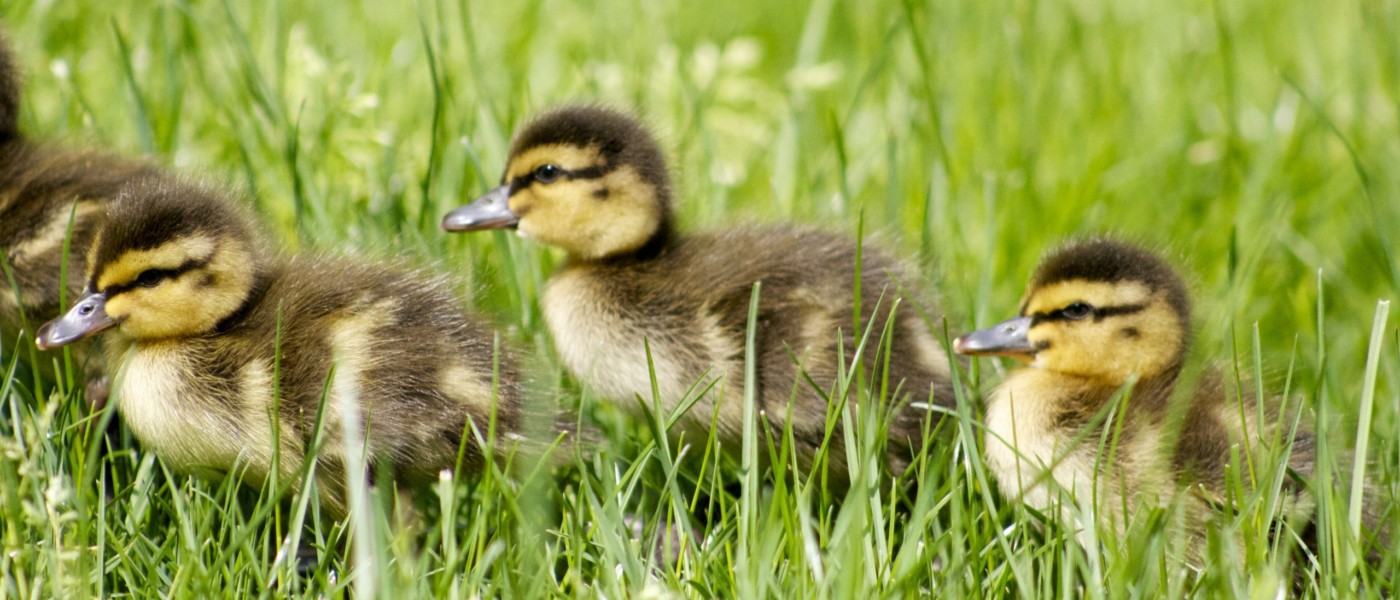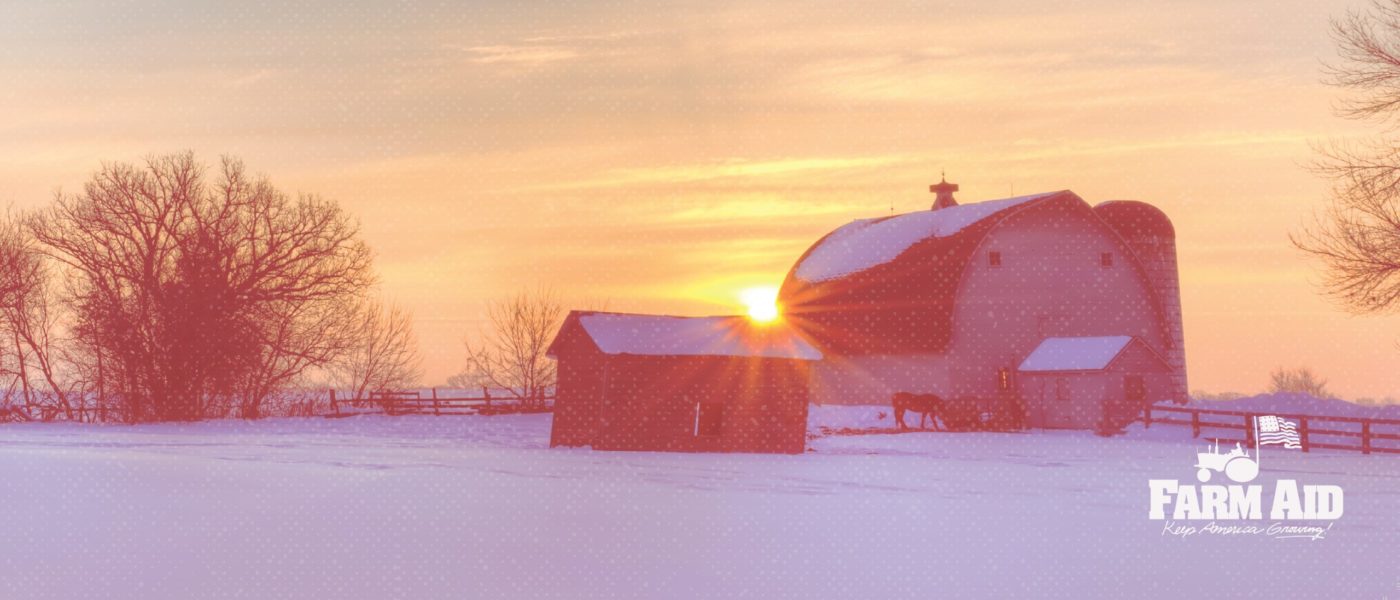The following 101, on raising ducks, comes from a HOMEGROWN contributor Lauren Klouda, of Honest Desires Farm. Lauren has broken each section below into two parts: First come the nuts and bolts that any prospective duck keeper needs to know (“the basics”), followed by insights Lauren has gleaned herself (“our experience”). Thank you, Lauren, for sharing your advice!
Why Raise Ducks?
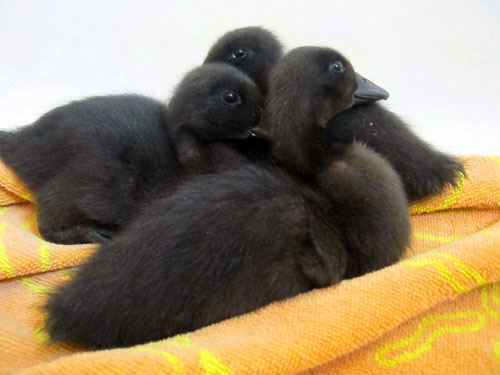
Photo © Lauren Klouda
The basics:
Why do you want to keep ducks: for minor pest control? For adorable pets? (Just a note that fuzzy ducklings grow up and have a lifespan of 8 to 10 years.) Do you want duck eggs for cooking and eating? Do you want to start the family tradition of dining on a Christmas duck? You don’t have to settle for just one goal; some breeds satisfy all of the above. Pinpointing your priorities will help you plan accordingly and pick a duck breed or breeds that meet your criteria.
As with chickens, there are bantam, light, and heavy breeds of ducks, all bred for various purposes. One of my favorite ways of exploring breeds is by visiting hatchery websites, including:
- Metzer Farms
- Murray McMurray Hatchery
- Holderread Waterfowl Farm & Preservation Center
- Moose Manor Farms
This last one offers sex-linked ducklings (more on sex-linking below). Unless you’re looking for a specific breed, I would recommend ordering from a hatchery as close to you as possible. Whatever breed you choose, one thing’s for certain: The ducklings will be adorable.
Our experience:
If we had taken my advice and thought about it ahead of time, we would have wanted ducks both for meat and for eggs—and that’s exactly what we got with our Cayuga ducklings. My husband, however, brought home a surprise for us this March, after years of me suggesting we try raising ducks, so I didn’t have much say in the breed selection. Although I had been interested in several other breeds, as well, I would have picked out the jet-black fluffy cuteness that is the Cayuga if I had been there myself. They are Just. Gorgeous. Ducks. (I would have been happy with white Pekins, too. Just saying.)
Finding Ducks
The basics:
As with chicks, there are hatcheries that sell ducklings (see links under “Consider Your Goals,” above). Since there’s usually a minimum quantity for placing an order, it can be expensive to ship only two or three birds. If you’re looking to start small, you might inquire about “chick days” at your local feed store—usually in the spring, around Easter—and explore Craig’s List, local farms, breeders, livestock auctions, and fairs. You could also consider purchasing eggs, as opposed to live ducklings, from hatcheries or on Ebay and hatching your own ducklings, although that might be a better approach for folks who have a year or two of duck keeping under their belts. (You can find links to great resources for locating all kinds of animals and farm products near you on Farm Aid’s Find Good Food from Family Farmers page.)
Our experience:
We purchased our ducklings from a local feed store in March for $10 a head—more expensive per bird than hatchery prices, but we saved on shipping costs for only three animals. That said, we didn’t have the advantage of knowing the sex of each bird until several weeks later. In the future, we’ll likely consider hatching our own by borrowing an incubator from a friend, purchasing birds from a fair (we just missed buying four runner ducks for $20 this weekend), and/or traveling to local farms that hatch the heritage breeds we’re interested in, such as the Silver Appleyard.
Brooding
The basics:
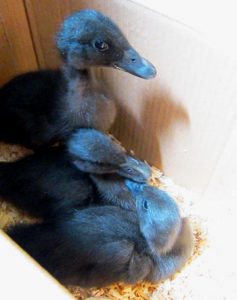
Photo © Lauren Klouda
Much like chicks, ducklings require warmth when they’re small. To that end, you’ll want to provide a box, spare bathtub, kiddie pool, or crate that you can keep clean. Make sure that kids and pets can’t get to the ducklings without your supervision and make sure to find an area with good ventilation but no drafts. As for the area’s interior, ducklings need secure footing in order to avoid leg problems. We used wood shavings without any difficulties, but our ducklings were accustomed to the shavings from the feed store. You want a material that is absorbent and easy to clean—and you’ll clean it often. Other options include old towels, paper towels, chopped straw, sawdust, et cetera. If your ducklings arrive from a hatchery or have just hatched, watch carefully to make sure they aren’t eating whatever bedding you choose.
Keep the brooder at 90 degrees for the first two weeks then lower the temp by 7 degrees a week. Watch your ducklings closely for signs of discomfort, as they don’t regulate their own body temperatures well until they are fully feathered, at about 7 to 9 weeks of age. If the ducklings are huddled together and peeping loudly, they need more heat—but make sure they can move away from the heat, too, as needed.
Plan on about half a square foot of space per duckling for the first two weeks then increase this to at least 1 square foot per duckling by week 4. At that point, ducklings should be feathered enough to be outdoors, with shelter and protection from predators, except in very cold or wet weather. Since they aren’t waterproof until they’re fully feathered, ducklings can get easily chilled and/or drown if you give them too much water. As fun as it is to watch ducklings swim, don’t let them do so unsupervised, and when they are splashing around, watch carefully to make sure they aren’t overly tired or cold. (More on ducks and water below).
Our experience:
We brought our ducklings home from the feed store when they were about a week and a half to two weeks old (we think). We had no problems with them mistaking the wood chips for food or getting confused about where their water was. They started off in a large rabbit cage with a removable tray, but we quickly decided we needed solid walls because they threw their food everywhere. We moved them to a medium-sized, high-walled plastic tub, with wood shavings and an aluminum widow-screen top. Then we moved them to a huge Rubbermaid tub with the same window screen.
Right away, on warm days, I would turn off the 250-watt heat lamp during the day, and they never seemed cold or uncomfortable. I would turn it on at night, but I’m not sure how necessary that was while the ducklings were still inside the house. Very, very quickly, though, we realized how messy they were—and how smelly when messy. I insisted we move them out of the house and into our unheated greenhouse. This was early April in northern Ohio. We set the wire rabbit cage back up, adding wood “walls” on two sides and the top. We mounted the heat lamp on one side, just outside of the cage, and we kept the wire door open, which acted as a ramp and let the ducks go in and out as they pleased. Their water was outside of the cage.
I don’t recall them being fully feathered at this point, but they were about 4 to 5 weeks old and did really well with this setup, despite some cool nights. As they grew, we herded them into a fenced daytime pasture that had some shelter from the sun, as well as a kiddie pool and grass, and at night we herded them back into the greenhouse. We did this for at least a month, until they were fully feathered, and then we got them settled into their permanent home.
Feeding
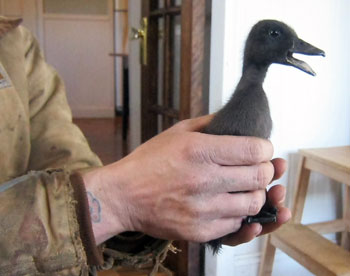
Photo © Lauren Klouda
The basics:
Some sources suggest feeding your ducklings “staged food”—starter then grower then layer—or feed formulated specifically for ducks. But you can also feed them regular chicken feed, though not medicated feed, since it’s easy for ducklings to eat more than is recommended and poison themselves.
Ducklings have higher niacin needs than chicks due to their rapid growth and bone development; sprinkling some brewer’s yeast on top of their feed at a 5 percent ratio should do the trick. Because water helps ducks swallow, wetting their feed or mashing it into a pulp can aid small ducklings’ digestion early on, although some people have found the mash to hinder swallowing. Watch your ducklings carefully and use your best judgment. Always discard wet feed at the end of the day to prevent mold. For variety, you can add chopped greens such as kale, Swiss chard, dandelion greens, grass, weeds, and peas to your ducks’ diet.
Grit—or specially formulated, finely crushed stone or sand—is crucial and should be sprinkled on your ducklings’ food. Grit works as teeth for ducks, chickens, and geese, and helps them digest their food. Once your female ducks, or hens, are laying, you’ll also want to offer them crushed oyster shells, which improve eggshell quality by adding calcium to the hens’ diet. Feeding grit and oyster shells “free choice” to adult animals allows them to judge how much of each they need for themselves. You can find these items at almost any feed supply store and at a growing number of garden centers.
Our experience:
We fed our ducklings the same feed as our laying hens. Because we had only three ducks but never fewer than 25 chicks in the brooder at a time, it seemed as though the ducklings ate very little by comparison. Most folks say, though, that ducks eat more than chickens. I watched the ducklings carefully for signs of growth problems, particularly in their wings and legs, but saw none—and that was before I knew to give them brewer’s yeast or that too much calcium could cause problems with wing development. In the future, I would feed ducks the same except I would add the brewer’s yeast right away. I would also offer them chopped fresh veggies early on, as my ducks have a hard time embracing anything new.
Watering
The basics:
Now for the million-dollar question: Don’t ducks need a pond? There’s a yes and a no answer, and I’ll leave it up to you to decide. What you must know is the following: Ducks need water. A week-old duckling can drink about half a gallon of water in a week; at 7 weeks, she can drink half a gallon each day. Be sure your ducks always have enough water, since food without water leaves them in danger of choking. In addition, ducks must be able to put their heads and bills into the water to keep their mucus membranes moist. As ducks eat, they grab mouthfuls of feed (or bugs or mud or worms) and swish it around in their water. Because of how they eat, it’s pretty impossible to keep their water clean for any length of time, so you should change their water daily and clean out the water container with a stiff brush and a solution, such as a vinegar-and-water mix.
There are some pretty fabulous ideas out there for using plastic jugs, such as milk gallons, as waterers to help cut down on duckling mess. The basic idea behind these types of waterers is that you cut a hole large enough for the duckling to put her head in the jug and reach the water but not large enough for her to climb in/bathe/make a mess/drown. Another idea is to set a shallow dish, like a ramekin, inside a slightly larger dish or pan, like a potted plant saucer. The saucer catches overflow and helps contain the mess. If you’re keeping newly hatched ducklings in a spare bathtub, position the waterer over the drain. (And not to sound like a broken record, but make sure your ducklings can’t drown!)
Adult ducks have oil glands at the base of their tails that effectively waterproof their feathers. Being able to submerge in water activates the oil glands. A kiddie pool, water trough, or other small tub is sufficient—and who wouldn’t want to let their ducklings practice swimming? The cuteness is off the charts. For wee ducklings, even a paint roller tray will do the trick; plus, supervising for safety means you get to watch the fun.
So, do ducklings and ducks need a pond to swim in? The answer is no, but a certain amount of swimming is necessary for their health and wellbeing, and seeing them play in the water is the best part.
Our experience:
I was pretty stern about not wanting to give the ducks any swimming water because I didn’t want mud. I learned my lesson. Due to the way ducks eat, mud is unavoidable, and really, who wants to deny a duck her swim? Watching our ducklings splash around in their water dish—and wondering how they squeezed into the dish to begin with—made it glaringly obvious that these ducks wanted to practice their stroke. First we put a very shallow plastic cup, then a baby chick waterer, in their indoor brooder. It didn’t matter what we did, there was always a mess—always. Then we transitioned them to a Rubbermaid dishpan when outside. This worked extremely well. They could get in and out without trouble, and they haven’t tipped it over yet. They even splash around in it now, as full-grown ducks. They have a kiddie pool, but the dishpan will remain their waterer in cold weather. (We still feed and water them outside their house. Indoor feeding would be a terrible mess.)
Housing
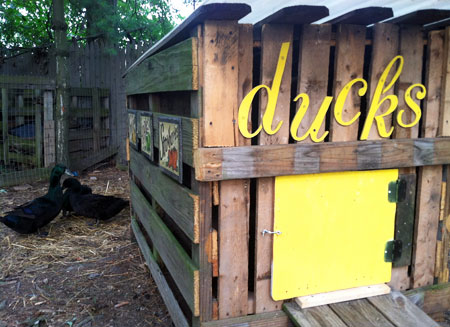
Photo © Lauren Klouda
The basics:
Ducks are tough birds. They’re waterproof, they have a thick down undercoat, and they have a layer of fat that chickens don’t have to keep them warm. Plus, ducks love rain and snow. So, unlike chickens, your ducks probably won’t need supplemental heat in winter. Protection from predators, however, is essential. Ducks emit a lot of moisture when they breathe, so it’s important to have good ventilation. Otherwise, there are few requirements for suitable duck housing. A converted doghouse will work; just make sure it’s easy to clean, at least 3 feet tall, and provides 4 square feet of area per duck. A thick bedding of straw is important since ducks don’t perch but instead nest on the ground. You can add a nest box if you’d like, but ducks are just as likely to lay eggs in the middle of the floor of the duck house.
Our experience:
Please see our Duck House 101!
Sexing: Boy or Girl?
The basics:
Telling your ducklings apart is no easy matter. Of course, you can order sexed ducklings, where the ducklings are vent sexed (basically, breeders check for the presence of boy parts) on the day that they hatch. Certain breeds can be identified as male or female by their down color. Otherwise, you might be left wondering whether you’ve got drakes (boys) or ducks (girls) until they’re fully grown and identifiable by their color or their laying habits (or lack thereof): Hens typically lay their first eggs around 21 to 24 weeks. Below is a great video from the folks at Metzer Farms on sexing by down color and the vent method.
There are a few other sex indicators you can watch for, before your ducklings grow into adults:
- Size: This is in NO WAY a sure thing, but male ducks are often larger. When observing a bunch of ducklings together—say, at the feed store—look for the ones with larger feet.
- Plumage sexing: This method isn’t too reliable until the duck is fully grown, at about 3 months. One our two feathers on a drake’s tail will curl up, while the female’s tail remains flat.
- Voice sexing: This is probably the best method for early gender identification. Female ducks make the loud “QUACK!” sound that we’re so familiar with. Male ducks don’t. See if you can’t start to identify voice changes early on. Females will begin to peep louder or make a wider variety of noises, while males will make more of a rasp or a hiss and are generally quieter.
Our experience:
We could tell pretty quickly that one of our three ducklings was a male: He was clearly the largest of all the ducks. It wasn’t until later that I realized the ducks were making different sounds. At that point, they were nearly fully grown and beginning to show their adult feathering. We were herding them one day when I realized only one was quacking. Sure enough, we have one girl and two boys. I held out hope for a while that the remaining duck in question was a girl. While it was definitely more colorful than our for-sure girl, it wasn’t as colorful as the large male. But the curled tail feathers confirmed it: two boys and one girl. A bummer but now we have Christmas dinner!
Benefits of Raising Ducks
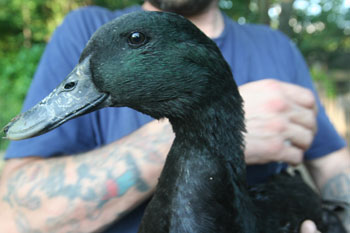
Photo © Lauren Klouda
The basics:
It has been said that ducks are healthier, more cold hardy, more heat tolerant, quieter, less aggressive in their pecking order, easier on the pasture, better at pest control, and better layers (through the cold and the heat, with healthier eggs overall) than chickens. You might or might not find all of these observations borne out yourself.
Our experience:
From a homestead and sustainability perspective, we find the ducks to be serious competitors to our chickens. For one thing, there’s the option of expansion: hatching future generations of ducks and replacing our stock. Whereas, as urban homesteaders, we could (maybe) get away with keeping a rooster—but only because we’re located near four major railway lines, a busy road, an airport, and neighbors who are used to noise and don’t complain.
Ducks are great foragers; seem easier on the grass, if given room; and are quieter—in a sense. We also see some minor income potential with ducks: selling ducklings, duck meat (processed legally, of course), and eggs. We have had people asking us for duck eggs since we first brought the ducklings home. We could price our duck eggs higher in the city than chicken eggs, without a corresponding increase in production cost, thanks to the law of supply and demand. Three ducks have cost us little in feed compared to our always hungry chickens. So, yep: We definitely see plenty of benefits to keeping ducks on the homestead.
And the Challenges
Ducks are wonderful, beautiful, and fun, but you need to know what you’re getting into. They aren’t chickens. They present their own challenges, especially in terms of keeping their water, pens, and houses clean. (Did I mention the importance of cleaning?!) They can stink. And they can drill holes into your property. When we first herded our ducks into a new pen, they dug holes—deep holes, easily 6 inches or more—for a couple of weeks straight.
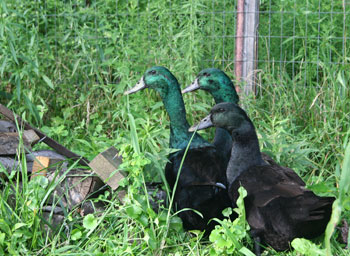
Photo © Lauren Klouda
Especially when startled, a duck can quack extremely loudly, equal to a rooster in suburban decibel level, and our ducks are easily startled. They haven’t warmed up to us yet, unlike our chickens. When we purchased first- and second-year layer hens from a farmer earlier this year, they were nearly wild. Now they are eager for petting, know their daily routine, and come running for food when they see us—all typical chicken behavior, in our experience.
On the other hand, in spite of our best efforts, our ducks have not tamed. They’re still very unsure of us and don’t recognize us as their feeders. We did try to bond with them, and things might have been different if we had hatched them ourselves, or if they had arrived from a hatchery just a day or two old. That said, we deeply enjoy their addition to our homestead and have even discussed replacing our chickens with ducks. (Don’t tell the chickens.)
